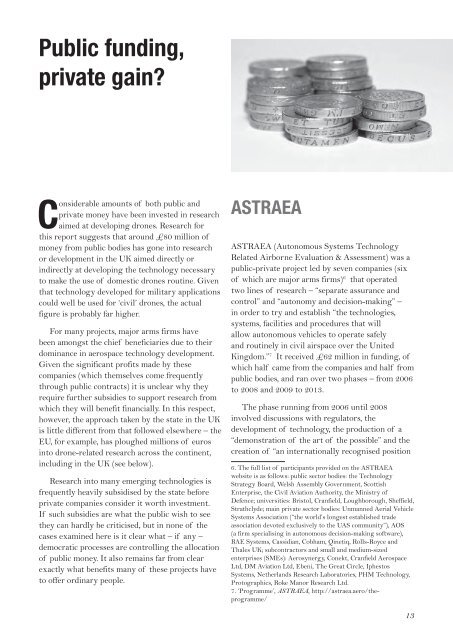Create successful ePaper yourself
Turn your PDF publications into a flip-book with our unique Google optimized e-Paper software.
Public funding,<br />
private gain?<br />
Considerable amounts of both public and<br />
private money have been invested in research<br />
aimed at developing drones. Research for<br />
this report suggests that around £80 million of<br />
money from public bodies has gone into research<br />
or development in the UK aimed directly or<br />
indirectly at developing the technology necessary<br />
to make the use of domestic drones routine. Given<br />
that technology developed for military applications<br />
could well be used for ‘civil’ drones, the actual<br />
figure is probably far higher.<br />
For many projects, major arms firms have<br />
been amongst the chief beneficiaries due to their<br />
dominance in aerospace technology development.<br />
Given the significant profits made by these<br />
companies (which themselves come frequently<br />
through public contracts) it is unclear why they<br />
require further subsidies to support research from<br />
which they will benefit financially. In this respect,<br />
however, the approach taken by the state in the UK<br />
is little different from that followed elsewhere – the<br />
EU, for example, has ploughed millions of euros<br />
into drone-related research across the continent,<br />
including in the UK (see below).<br />
Research into many emerging technologies is<br />
frequently heavily subsidised by the state before<br />
private companies consider it worth investment.<br />
If such subsidies are what the public wish to see<br />
they can hardly be criticised, but in none of the<br />
cases examined here is it clear what – if any –<br />
democratic processes are controlling the allocation<br />
of public money. It also remains far from clear<br />
exactly what benefits many of these projects have<br />
to offer ordinary people.<br />
ASTRAEA<br />
ASTRAEA (Autonomous Systems Technology<br />
Related Airborne Evaluation & Assessment) was a<br />
public-private project led by seven companies (six<br />
of which are major arms firms) 6 that operated<br />
two lines of research – “separate assurance and<br />
control” and “autonomy and decision-making” –<br />
in order to try and establish “the technologies,<br />
systems, facilities and procedures that will<br />
allow autonomous vehicles to operate safely<br />
and routinely in civil airspace over the United<br />
Kingdom.” 7 It received £62 million in funding, of<br />
which half came from the companies and half from<br />
public bodies, and ran over two phases – from 2006<br />
to 2008 and 2009 to 2013.<br />
The phase running from 2006 until 2008<br />
involved discussions with regulators, the<br />
development of technology, the production of a<br />
“demonstration of the art of the possible” and the<br />
creation of “an internationally recognised position<br />
6. The full list of participants provided on the ASTRAEA<br />
website is as follows: public sector bodies: the Technology<br />
Strategy Board, Welsh Assembly Government, Scottish<br />
Enterprise, the Civil Aviation Authority, the Ministry of<br />
Defence; universities: Bristol, Cranfield, Loughborough, Sheffield,<br />
Strathclyde; main private sector bodies: Unmanned Aerial Vehicle<br />
Systems Association (“the world’s longest established trade<br />
association devoted exclusively to the UAS community”), AOS<br />
(a firm specialising in autonomous decision-making software),<br />
BAE Systems, Cassidian, Cobham, Qinetiq, Rolls-Royce and<br />
Thales UK; subcontractors and small and medium-sized<br />
enterprises (SMEs): Aerosynergy, Conekt, Cranfield Aerospace<br />
Ltd, DM Aviation Ltd, Ebeni, The Great Circle, Iphestos<br />
Systems, Netherlands Research Laboratories, PHM Technology,<br />
Protographics, Roke Manor Research Ltd.<br />
7. ‘Programme’, ASTRAEA, http://astraea.aero/theprogramme/<br />
13


